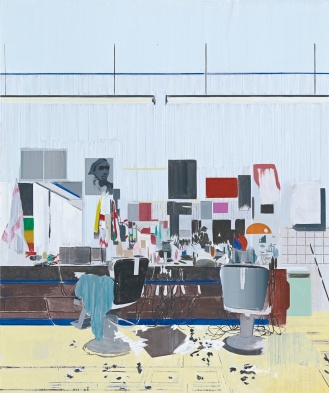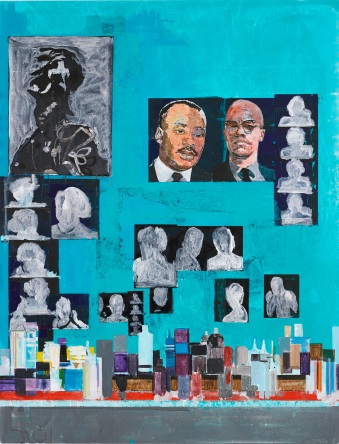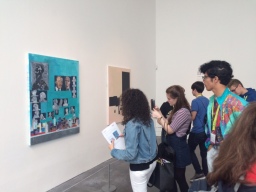How do images from our past shape our present self? And how can contemporary art help us to explore personal memories and collective ones? These were just some of the questions that we considered on a recent visit to New Art Exchange with students on the historical strand of the Sutton Trust Summer School. I’ve blogged before about the fantastic work that the Sutton Trust does in widening participation to higher education and about how intellectually engaged, curious and imaginative the students on this scheme are. This year, we held part of our session at New Art Exchange (NAE) in the exhibition Hurvin Anderson: Dub Versions.
Anderson is a contemporary artist born in Birmingham to Jamaican parents; his paintings explore ideas of place, memory, and personal and collective identity. Included in the exhibition at New Art Exchange were a group of paintings that relate to previous depictions of a domestic barbershop that Anderson recalled from his childhood in the Midlands. The 2006 painting Barbershop, though not included in the NAE exhibition, was an important source for several of the works on display there. It depicts chairs on a hair-strewn floor in front of a bench filled with bottles of product. Typical of the small businesses opened by Carribbean immigrants to Britain in the 1950s and 1960s, the place that Anderson recalls was one that served as much more than a hairdressers, fulfilling an important function as a social gathering place for immigrant communities.

Hurvin Anderson, Barbershop, 2006, oil on canvas.
Anderson has described the barber’s practice of displaying not only photographs indicating potential cuts but also portraits of key black figures from history, and from the worlds of sport and entertainment. In Barbershop they appear as blocks of colour on the canvas. In a large, horizontal collage that appears in the NAE exhibition we identified several famous figures: Martin Luther King, Jr. and Malcolm X appear alongside Michael Jackson and Lieutenant Uhura from Star Trek, one of the first African American protagonists to appear on American television. This constellation of references would have served to construct a group identity for the community gathered in the barbershop, so that the community developed a sense of identity via points of reference from different periods and places. In Anderson’s work these iconic figures from history and culture suggest the major narrative of history, but they appear alongside more minor histories embodied in family snapshots or blurred outlines of anonymous people. Unknown names are as much a part of this history as famous ones; in this arrangement, as on the barbershop mirror, personal and group histories collide.

Hurvin Anderson, Is It Okay To Be Black?, 2016
Many of the paintings in the NAE exhibition, including its centrepiece, Is It Okay To Be Black (2016) are based on this preliminary collage, which in turn developed out of that earlier painting. They repeat its forms, composition, and imagery to a greater or lesser degree, verging from those that retain some semblance of the barbershop setting to those that reduce the scene to abstract geometric forms. Across several new works, the space of the barbershop is re-imagined and reformed, just as places from our past are reshaped in our memory. The arrangement of photographs in the collage appears in the paintings a series of shapes, some retaining definition and clarity and others rendered as hazy outlines. In the more abstract renderings, the students observed references to the rhythms, sounds, and colours that can evoke places and sensations from the past. In the repetition of forms that fade in and out of visibility, the paintings thus seem to echo the structures and experiences of memory.

Sutton Trust students at New Art Exchange
Among the group, the art sparked discussions about how we remember and forget, and how both processes can depend on our present surroundings. We talked about the ways in which our present selves are constituted from these fleeting past recollections as well as from those historic and cultural references that we inherit from our parents, community, and wider cultural group. As Anderson’s works reveal, identity is a many-layered thing that exists in multiple places and times; belonging can come in many forms. Now more than ever, this seems crucial.
Dr Lucy Bradnock (Assistant Professor, History of Art)
Hurvin Anderson: Dub Versions is at New Art Exchange until 18 September 2016.